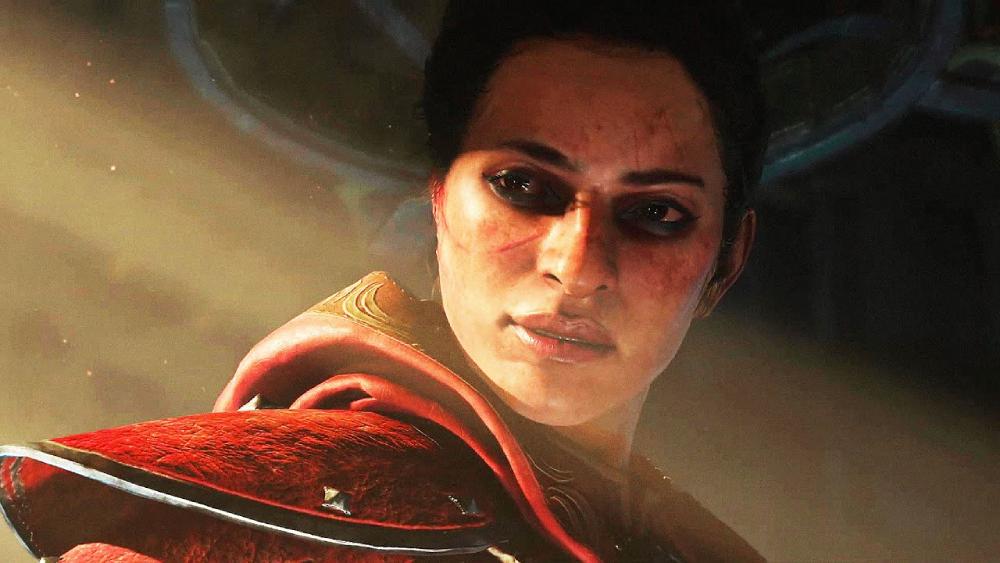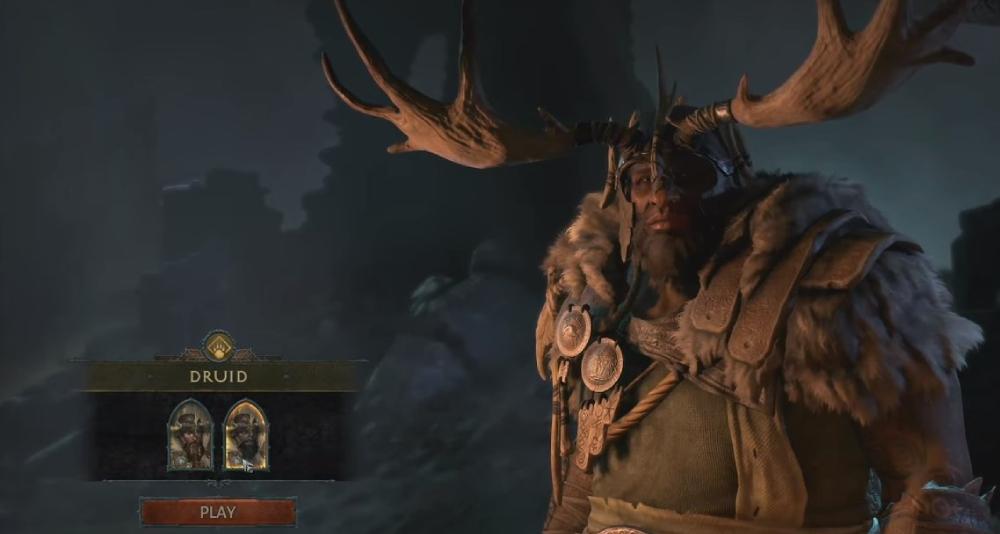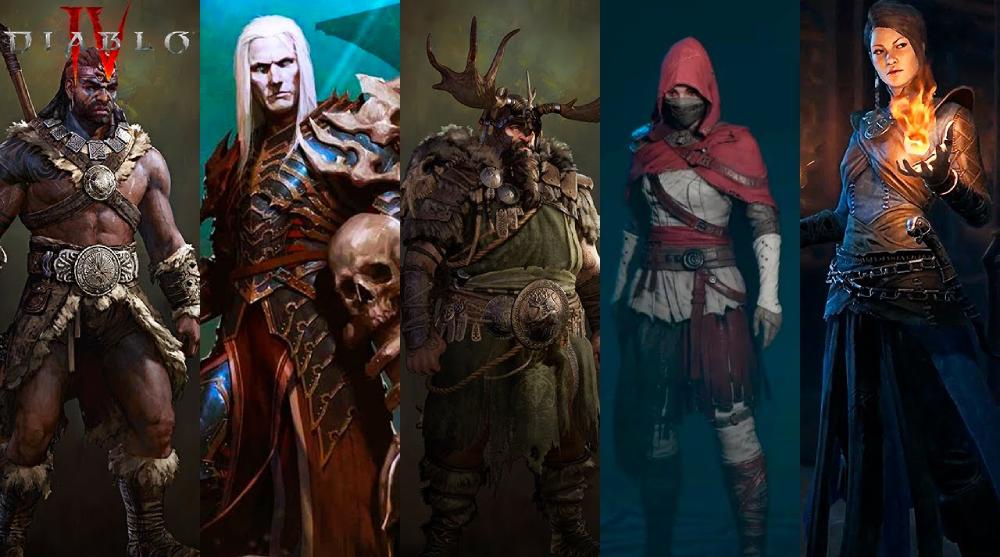Physical Address
304 North Cardinal St.
Dorchester Center, MA 02124
Physical Address
304 North Cardinal St.
Dorchester Center, MA 02124

Are you a fan of the gothic genre of games? Diablo IV is here, and it will premiere in mid-2023. Since the announcement of the game years back, everyone has been drawing speculations about the classes in the game. The classes are one element that the Diablo series has maintained in its titles.
The selection of a class in Diablo IV is a crucial aspect of the game. Your choice at the beginning will determine your playstyle, required resources, and starting stats. It’s essential to pick a class that you will enjoy playing throughout the extensive gameplay of Diablo IV.
There are five different classes to choose from in Diablo IV: Barbarian, Sorceress, Rogue, Necromancer, and Druid. However, the Barbarian and Necromancer, which were present in Diablo 3, have undergone significant changes in this game. In this article, we’ll provide an overview of each class to help you make an informed decision. If you’re looking for answers concerning the best class or a specific Diablo 4 class, you’re in the right place.

Diablo IV is a new action role-playing title from Activision Blizzard. The Diablo title became famous due to its gothic nature and scenes featuring demons and angels. Diablo IV is similar to the previous three titles in matters regarding gameplay. However, Diablo IV is changing the narrative and building on the criticism received on Diablo III. Therefore, this new title takes you back to the gothic roots of the Diablo series with all its bloody and horrific scenes but great gameplay.
In Diablo IV, the main villain, Lilith, returns to the scenes after being summoned through a ritual. Lilith is one of the Sanctuary founders and the daughter of Hatred. Sanctuary is where the game scenes of a battle between heaven and hell occur. Lilith was fed up with the Eternal Conflict, and together with Inarius, they stole the Worldstone and created a Sanctuary. However, the birth of powerful creatures began a rivalry between the duo, and Lilith was expelled from Sanctuary. Lilith is now back in Sanctuary, and it’s time to ready your war tools and go into battle.
Ultimately, Diablo IV aims to immerse players in a more perilous and gritty world, one that is even more deadly and unforgiving than previous iterations of the game.
There are a total of five classes in Diablo IV, with each class possessing different abilities. As a result, the class you choose will determine your skills and battle style. The five classes in Diablo IV are Necromancer, Rogue, Sorceress, Barbarian, and Druid.
Below is a look into the Diablo IV classes and everything they entail.

The Necromancer is the fifth and final class in Diablo IV, and it specializes in summoning corpses to fight alongside the player in battle. The Necromancer can use a wide range of weapons, including swords, daggers, wands, and scythes, which are exclusive to this class. Similar to the Necromancer in Diablo III, this class relies on the Essence resource to activate powerful skills. Corpses, which can be obtained from fallen enemies or spell effects, are another valuable resource that the Necromancer can utilize, even including the fan-favorite Corpse Explosion.
The Necromancer has four unique playstyles: Bone, Darkness, Blood, and The Army. Bone skills primarily deal physical damage and consume Essence resources, with the Bone Prison being one of the most notable spells that can ensnare multiple enemies. Darkness focuses on inflicting damage over time, making it an excellent choice for those who want to torment their enemies. Blood allows the Necromancer to become a bloodthirsty vampire, restoring their own health and strength by absorbing the HP of enemies, culminating in an explosion that deals additional damage. Finally, The Army style lets the Necromancer resurrect skeletons and construct golems to fight by their side.
The Necromancer’s unique class mechanic is the Book of the Dead, which allows further customization of the player’s undead army. For example, Skeleton Warriors can become Skirmishers who deal more damage at the cost of a lower health pool or Defenders who inflict less damage but are expert tanks. Sacrificing specific minions can also grant permanent buffs, improving the player’s build.
In Diablo 4, the Summoner is an archetype of the Necromancer class, specializing in raising and commanding an army of undead minions to do their bidding
Overall, if you’re looking to summon armies of corpses and crush your enemies, the Necromancer is an excellent choice of class for you in Diablo IV.

The Rogue in Diablo IV is a stealthy assassin who possesses great agility and can swiftly maneuver in combat, allowing them to gain an upper hand or retreat if necessary. Their arsenal includes both melee and ranged weapons, such as daggers, swords, and bows, making them a versatile class. While bows may not be as powerful as other weapons early on, they allow the Rogue to attack from a safer distance, reducing the chances of getting hit frequently. To find out more about mastering bows, read here. The Rogue can be thought of as a combination of Diablo II’s Amazon and Diablo III’s Demon Hunter.
In terms of equipment, the Rogue class is expected to have access to a range of different armor sets, which will offer different bonuses and bonuses depending on the player’s playstyle and preferences.
To maximize the Rogue’s potential, it is recommended to focus on Dexterity, Strength, and Intelligence. Dexterity amplifies skill damage and improves dodge ability, Strength enhances energy regeneration rate, and Intelligence improves critical hit chance and overall resistance.
This is where you can find out more about the complete Rouge skill tree, but please note that Diablo 4 is a constantly evolving game and therefore the information provided is not set in stone.
The Rogue’s unique class mechanic is called Talent Specializations, which includes Combo Points, Inner Sight, and Preparation, each with its own questline. Combo Points are earned by using basic Rogue skills, which can then be consumed with core skills to trigger additional effects. Inner Sight allows the Rogue to fill a gauge by attacking marked enemies, which provides unlimited energy for a short period of time and is effective against bosses. Preparation is available at level 30, but it has not been tested yet.
Moreover, the Rogue can imbue attacks with specific effects such as Poison, Shadow, and Cold, which are usually applied to Core Skills and abilities that deal damage against multiple enemies, such as Rapid Fire. If you’re looking for a fast-paced class that excels in dealing physical damage with both melees and ranged weapons and can quickly shift positions in combat, the Rogue is an excellent choice.

The Sorceress is a Class that operates on a high-risk, high-reward basis due to their vulnerability, but their powerful elemental Spells make them a force to be reckoned with. This class is #1 in the Pillar of Gaming’s Diablo 4 class tier list. Fire Spells are effective in dealing damage over time with the Burning status effect, but they may not be as useful in controlling the battlefield early on. On the other hand, Cold Spells are great for crowd control and can slow down or even freeze enemies, making them ideal for boss fights. Additionally, Lightning Spells offer a balanced combination of damage dealing and encounter control, with some abilities providing either damage to enemies or Mana restoration.
To optimize your Sorceress build, allocate points into Intelligence to boost Spell damage, Dexterity to improve Mana recovery, and Willpower to increase critical hit chance. The Sorceress has a unique class mechanic known as the Enchantment System, which allows players to transform active abilities into passive bonuses by placing them in dedicated Enchantment slots. This system allows for greater customization and flexibility in gameplay, with the possibility of triggering multiple targets with heavy Fire Damage using Meteor, for example.
The Sorceress class in Diablo 4 will feature the Hydra skill. In Diablo 4, the Hydra skill will allow the Sorceress to summon multiple hydra heads that will attack enemies with fire damage. The hydra heads will be able to target multiple enemies at once, making it an effective skill for dealing with groups of enemies. Additionally, the Sorceress will have the ability to customize her Hydra skill by choosing different elemental variations, such as ice or lightning, to suit different combat situations.
If you’re seeking to master the art of powerful elemental magic that deals damage from afar and hinders enemies, then the Sorceress Class is the perfect choice for you!
It might be worth checking out:

The Barbarian Class in Diablo IV is an excellent choice for players who prefer to engage in close combat and deal heavy physical damage. Compared to other Classes, Barbarians are more focused on physical damage and straightforward offensive and defensive moves.
Barbarians have a unique class mechanic called the Arsenal System, which allows them to equip and switch between four different types of Weapons, including Main Hand, Off-Hand, Bludgeoning, and Slashing Weapons. This feature enables better customization and allows for assigning specific equipment to certain Skills based on the player’s needs. For instance, a Bludgeoning Weapon is suitable for the Bash Skill, which stuns and heavily damages targets, while a Two-Handed Bludgeoning Weapon can increase stun duration further. Upon activation of a Skill, the best Weapon in the loadout is automatically equipped.
Each Weapon has a corresponding Expertise stat, which can be leveled up to enhance various attributes, such as Critical Strike Chance or Bleed damage. It’s recommended to collect a wide variety of melee Weapons to take advantage of the Barbarian’s build diversity and itemization progression. Additionally, investing in Strength amplifies damage, Willpower improves Fury regeneration, and Dexterity increases critical hit chances.
Barbarians excel at annihilating mobs of enemies and can focus on single powerful targets like Bosses by dealing Bleed damage. However, some Skills have long cooldown rates, which can slow down their damage output. The Barbarian’s abilities are versatile, ranging from inflicting Bleed and crowd control techniques to enhancing self-buffs to maximize physical damage.
If you enjoy obliterating enemies and facing challenging Bosses using various melee Weapons, then the Barbarian Class might be a great fit for you.

The Druid is the next Class in Diablo IV that possesses the remarkable capability to shift physical form from a human to that of a Werewolf or Werebear, instantly transforming when using their beast-themed Skills prior to executing the corresponding actions. It should be noted that this transformation is temporary and will only last for a short duration until another move is executed. To find out more about Druid customization opportunities, read this article.
In addition to their shapeshifting abilities, the Druid is also skilled in using Earth and Storm Spells to debilitate foes while battling the forces of evil. For example, they can use Crushing Blow to deal damage to a target based on a percentage of their total Life, but some of their Skills leave them Vulnerable, resulting in significant additional damage from subsequent hits.
The Druid’s Companions do not require summoning and automatically attack on their behalf, with respective active Companion Skills to inflict damage on specific targets. Not much is currently known about this Class’s Stats, as well as the Necromancer.
The Druid’s unique class mechanic is linked to obtaining special loot, which must be offered to spirit animals to receive different passive bonuses based on the spirit’s type. It is unclear how many types of spirits are available, but each of them can provide up to 6 offensive and defensive passive effects.
If you enjoy experimenting with various playstyles that allow you to transform into another form and unleash elemental fury, then the Druid Class is worth playing!
You may also find useful:

In Diablo IV, there is no single “best” class, as all of them are viable and offer unique playstyles to choose from. Players should select a class based on their preferred playstyle and adjust their build accordingly for optimal performance. For instance, those who enjoy playing as a tank should consider the Barbarian, while those who prefer crowd control may enjoy the Sorceress.
Players have a plethora of options at their disposal and can tailor their chosen classes to fit their individual preferences. For beginners to the Diablo series, it is recommended to start with the Barbarian due to their high health and forgiving playstyle. Sorcerers and Rogues, while dealing more damage, have less health and are more susceptible to defeat.
Alternatively, the Druid class may also be a good option for beginners as they offer a sturdy defense while still allowing for ranged attacks.
Different classes in Diablo IV will offer you different skills and abilities. This guide’s guidelines will help you choose the perfect class to suit your playstyle.